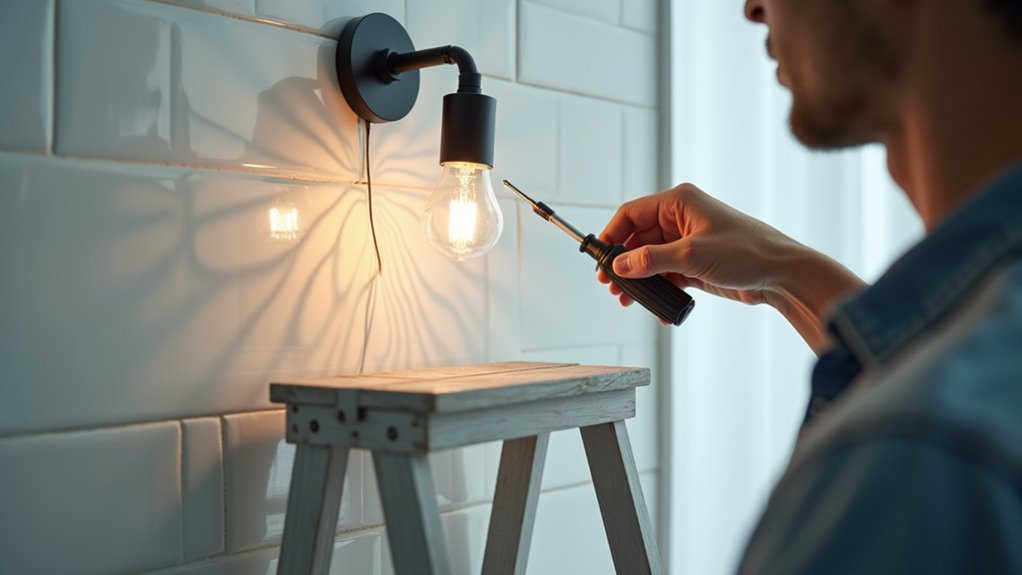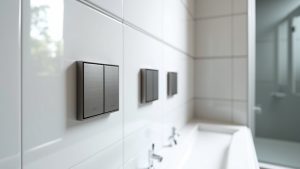A flashing bathroom light often signals issues like loose or incompatible bulbs, faulty wiring, or malfunctioning switches. Initial steps include inspecting bulb installation and sockets for damage. Next, check for loose connections or frayed wiring, particularly in older homes. If using LEDs, ensure compatibility with dimmers and assess the driver for faults. Additionally, monitor for voltage fluctuations caused by heavy appliances. For further insights into addressing these problems, more detailed troubleshooting options are available.
Key Takeaways
- Check and tighten the bulb to ensure it is securely installed in the socket to prevent flickering.
- Inspect all wiring connections for looseness or damage, as these can cause intermittent power supply issues.
- Examine the switch for any signs of overheating or damage, and replace if necessary to ensure a proper connection.
- Ensure the light fixture or bulb type is compatible with the circuit, especially if using LED bulbs with older dimmers.
- Look for voltage fluctuations caused by heavy appliances nearby, and reduce circuit loads to stabilize power supply to the light.
Identify the Bulb-Related Issues

How can one effectively identify the various issues related to bathroom light bulbs?
First, one must assess the installation conditions. A loose or improperly installed bulb can lead to intermittent contact with the socket, resulting in flickering or failures. A loose connection may also be present, which could indicate a more serious safety concern if not addressed.
Socket damage, such as corrosion, may hinder a proper connection, also impacting the bulb lifespan. Attention should be given to the type of bulb utilized; incompatible types can exacerbate issues. Additionally, consider the bulb’s age: as filaments age in incandescent bulbs, instability may lead to flickering, and fluorescent bulbs may indicate nearing failure through darkened ends. Quality bulbs are less likely to fail, ensuring better performance and longevity.
Identifying these factors ensures a systematic approach to resolving frequent lighting disruptions in the bathroom.
Check for Wiring and Connection Problems

A thorough examination of wiring and connection problems is crucial when diagnosing issues with bathroom lighting. Loose connections, particularly in fixtures or junction boxes, can lead to intermittent power and hazardous arcing. Inspecting each connection is essential; ensure that wire nuts are secured and not overcrowded, as loose wire nuts may disrupt power flow. Additionally, degraded wiring, often an issue in older homes, contributes to inconsistent electricity that can cause flickering. Look for physical damage or fraying near fixtures, as these conditions pose significant electrical hazards. It is important to use ground fault circuit interrupters (GFCIs) in bathrooms to prevent electrical shocks and improve safety compliance. Always power off circuits before inspection, and if any connections show burn marks or discoloration, these may indicate overheating due to poor connections, necessitating immediate attention from a professional. Proper grounding using bare copper or green wire is essential to prevent electrical hazards and ensure safety compliance.
Investigate Switch Malfunctions

Following an assessment of wiring and connection issues, the next step involves investigating potential malfunctions of the light switch itself. Malfunctioning switches can lead to various problems, including flickering lights and delayed responses. Modern switches, such as toggle switches, are known for their durability and may need replacement if they malfunction. To ensure electrical grounding prevents shocks, check that the grounding wire is properly connected in even minor repairs like switch replacement. Key indicators of switch malfunctions include:
- Flickering Lights: Suggests a loose connection within the switch that may require replacement.
- Warm Switch Plate: Indicates possible overheating due to mechanical wear or faulty wiring.
- Unusual Noises: Audible sounds like buzzing or cracking reveal internal failures, necessitating immediate switch replacement.
Upon identifying these signs, replacing the switch is essential to mitigate safety risks and ensure reliable operation.
Ignoring these issues can lead to further complications and hazards.
Examine LED Specific Issues

Investigating LED-specific issues is crucial for diagnosing persistent lighting problems.
LED driver failures are a common cause of flickering, as malfunctioning drivers struggle to convert AC to DC power consistently. Additionally, dimmer incompatibility can arise from using outdated dimmer switches not engineered for LEDs, leading to rapid power cuts unsuitable for these bulbs.
Overheating issues exacerbate this problem; poor heat dissipation can degrade internal components, causing flickering.
Bulb quality is also significant; low-cost LEDs often utilize inferior components, increasing the likelihood of early driver failure. In contrast, high-quality bulbs, despite a higher upfront cost, tend to offer more reliable performance and extended lifespans, mitigating frequent replacements and repairs associated with cheaper alternatives.
Assess Power Supply and Circuit Problems

Power supply and circuit issues are key components to examine when troubleshooting flickering bathroom lights, particularly after assessing LED-specific factors. Addressing these concerns can prevent further complications.
- Power Fluctuations: Voltage variations from heavy appliances can cause flickering. Frequent fluctuations may indicate a significant electrical issue requiring a professional evaluation.
- Circuit Overloads: Excessive appliances on a single circuit lead to temporary power dips. Older homes are often more susceptible, and redistributing appliances can reduce overload risks.
- Loose Wiring Connections: Loose connections can create inconsistent power. These may occur at switches or fixtures and pose a fire risk, necessitating professional inspection for safety.
Taking these steps can help identify and resolve flickering bathroom lights effectively.




